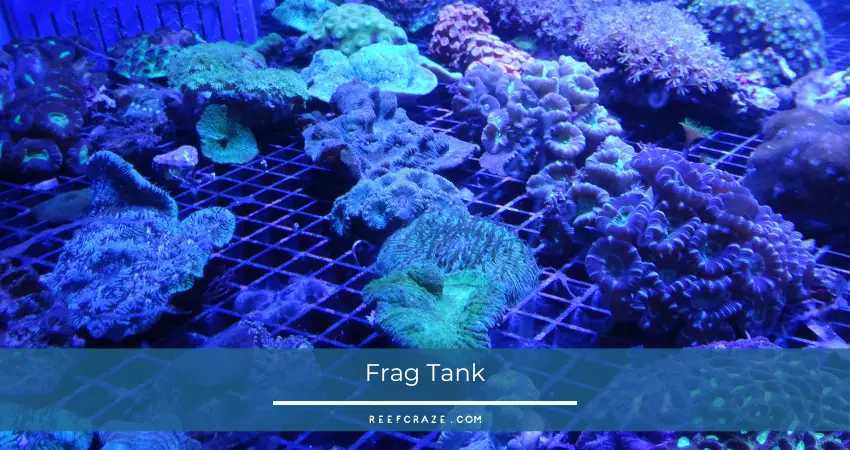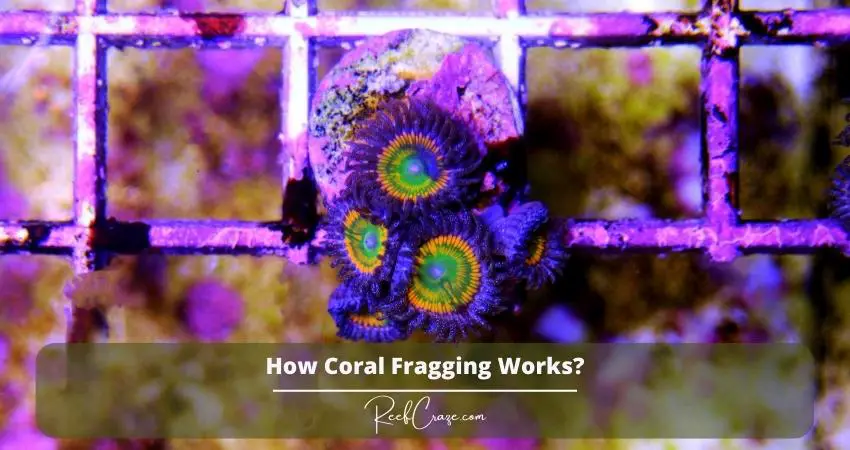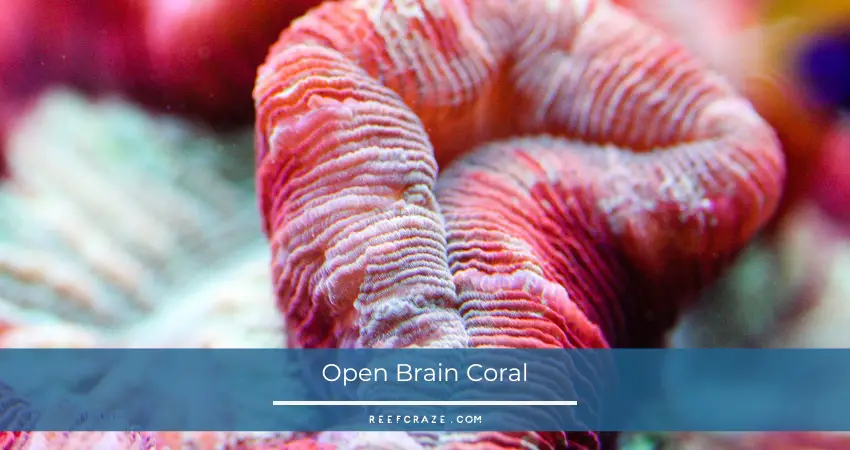Researchers are claiming that the world could lose 99% of its natural coral reefs by 2030. Many have put 2050 down as the year when corals will become extinct. However, frag tanks are one of the notable preservation efforts that could stop corals from disappearing forever.
Frag tanks are dedicated tanks for growing cut or fragged coral sections. The tank may share the water from your reef tank or be a standalone unit. Fragged coral raised in these tanks has a higher rate of acclimation and turns out healthier than wild coral.
To understand how impactful frag tanks are for coral preservation, let’s take a deep dive into fragging, the types of tanks, the process, and the beginner-friendly corals you can start with.

What Is Fragging, And What Are The Benefits?
Fragging is the natural or artificial removal of a piece of coral from its main body, which can latch onto a new surface and grow to a full size. It’s a process that can happen naturally to wild corals through strong currents and underwater debris impacts. But more importantly, you can cut corals and raise them in frag tanks in this method.
If you choose to frag corals over purchasing them, you can enjoy these benefits.
- You can save a lot of money and effort by fragging. Purchasing enough coral for your reef tanks can easily add $40-550 as a one-time expense. You’ll risk additional costs from the coral not acclimating to your tank and dying.
- You’ll reduce the load on wild coral reefs. It’s prohibited to collect from wild coral reefs in almost every location in the world. But the demand for wild corals is enough to break that law for some people. By choosing to frag corals, you’ll help lower that demand.
- You’ll have better acclimation rates with fragged corals. Fragged corals are raised in your tank climate and often share water with your reef tank. So, fully grown fragged corals will have a higher rate of survival than purchased or wild corals and won’t carry harmful sediment, bacteria, or pathogens.
- Selling the corals grown from fragging can net you a nice profit. You’ll be providing a robust, healthier, and environmentally friendly alternative that’s very attractive to buyers. You can make from $40-120 from each sale, depending on the species.
Fragging corals at large can help sustain the wild coral population. It helps many hobbyists keep corals in their tanks without worry, and it helps you make decent returns on your hobby project. So, it’s a no-brainer to pick up coral fragging if you’ve already got a reef tank.
What Types Of Frag Tanks Can I Use?
There are many variations of frag tanks out there. When picking one, you have to ensure that it fits your experience, intention, and budget. To help you figure things out, we’ll look into these 4 base types.
- Display frag racks.
- Sump frag tanks.
- Integrated frag tanks.
- Standalone frag tanks.
1. Display Frag Racks
Display frag racks are an inexpensive, beginner-friendly option for frag tanks. It’s a magnetic rack that attaches to your reef tank, sharing the water and resources, ideal for gaining experience or for breeding coral for your tank. However, tacking on frag racks can ruin how your tank looks. You can get a decent display frag rack for $30-184.
2. Sump Frag Tanks
Sump frag tanks are compartments in saltwater tank sumps that can be used to grow coral frags. This can help you hide your frags and make your tank look less messy. But this will cause issues with water flow to your frags, and you’ll need a wavemaker to fix stagnancy or overflow. A good sump frag tank will cost you $16-294 to set up.

3. Integrated Frag Tank
Integrated frag tanks are physically separate but share the water flow with your saltwater tank through tubes interconnecting the 2 tanks. This will save you from the hassle of maintaining 2 tanks and help acclimate the frags to your main tank faster. However, any diseases or toxicity buildup will spread to both tanks. You can get an integrated frag tank set up for $158 and up.
4. Standalone Frag Tanks
Standalone frag tanks are separate tanks that require their equipment and filtration. While this is the most expensive option, it’s also the best option if you plan to sell fragged coral. You can regulate the conditions of the tank better and control coral size. Standalone frag tanks will cost around $500 to set up.
You’ll find many variations of these 4 base types of frag tanks on the market. If you want to learn how to frag or just want to grow your corals, then go for the simplest display frag racks. But if you plan to sell your corals, then you should spend a bit more and go for a good standalone frag tank.
The Fragging Process
Fragging corals for the first time can be an intimidating experience. It’s easy to overlook things and miss vital steps during the process. It’s best to have a list of things prepared that you can check and double-check against to see if you’ve missed anything. To help you out, here’s a list of things you’ll need to frag corals.
- New razor blades.
- Clean towels.
- Live rock or frag plugs.
- Rubber bands.
- A small bowl.
- Reef glue.
- Plastic wraps.
I’ve briefly touched on the fragging process below. You can quickly look over this while fragging to check your work.

1. Cycle Your Tank
Before anything else, you should let your frag tank finish its nitrogen cycle. If you’re using a display frag rack or interconnected frag tanks, then check your nitrite, nitrate, and phosphate levels, along with acidity. Your frags will not survive in a hostile environment.
2. Sterilize Your Equipment
Sterilize everything you’ll use to frag your coral. This reduces the risk of your coral dying and introducing diseases to the tanks. Coral fragged with sterilized equipment will also heal and grow faster.
3. Cut The Parent Coral
To frag the parent coral, take it out of the tank. Set it on towels to keep the workspace dry. Use the razor blade to cut the entire cap off the coral.
4. Clean The Coral Frag
Fill the small bowl with tank water and deposit the coral frag in it. White stringy strands will come out of the cut areas, and brow liquid will ooze out. Wait till the frag is done oozing, and then take it out.
5. Tie The Frag To Live Rock Or Frag Plug
Use the towel to dry the base of the frag, so it can stick to the live rock or frag plug. Place it on the plug or rock, then use plastic wrap and rubber bands to hold it all together. Place the frag into the frag tank and return the parent coral to the tank.
6. Let Everything Heal
Wait till you’ve noticed the frag heal and grow a disk-like head. You’ll also notice that the frag has attached to the rock or plug.
7. Finish Up
Remove the plastic wrap, and use reef glue to stick the plug or rock to your main tank. You can also grow it out in the frag as needed for selling later. Remember, you’ll want a lower water flow wherever you place your frag.
Additional Read: How to frag Zoas
Best Choices For Fragging
If you’re just starting with fragging, it’s best not to go for sensitive species. You should stick to the more resistant, beginner coral species that can handle a few mistakes and recover faster. You can check out these 5 species for the best results.

- Open Brain Coral: Open brain corals are large flopping and fleshy polyps attached to a small skeleton structure. It looks brilliant under low-light conditions, but its best attribute is its resistance and ease of care.
- Trumpet Coral: Trumpet coral is a fast-growing, large coral that’s the perfect choice for fragging. You can make multiple frags from the same parent coral, and they recover faster than most other species.
- Leather Coral: If you want to sell corals, then leather corals are great choices. They are self-cleaning and act as centerpieces in any tank. They are beginner-friendly, so you won’t have issues finding customers.
- Star Polyps: These are the most inexpensive and readily available species of coral. They aren’t ideal choices for selling, but you can practice with them for cheap.
- Bubble Coral: Bubble corals are a tad more delicate, as they can’t stand strong currents. They also need plenty of room and don’t like hard surfaces. But they are good-looking and go for a good market value.
Wrapping Up
The ideal way to set up your frag tank is to include small fish species that cohabit with corals. This will help provide a lot of food for the corals and help cycle the bio-load in the tank. You can always opt for coral-only frag tanks, but that’s only recommended if you intend to sell your coral.
